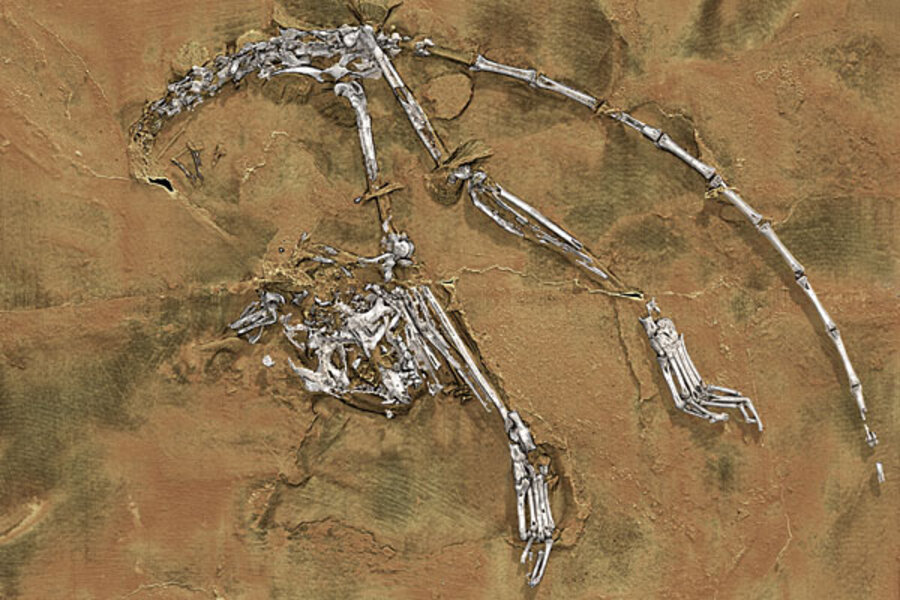How did human 'cousin' look 55 million years ago? Fossil offers clue.
Loading...
The fossilized remains of a tree-dwelling fuzzball smaller than a mouse are giving scientists a "unique" glimpse of how one group of primates looked shortly after it diverged from the line that would later become monkeys, apes, and humans.
The remains, unearthed in China and estimated at 55 million years old, are some 7 million years older than the next oldest primate fossils, according to a team of scientists describing the discovery in Thursday's issue of the journal Nature.
"There's nothing else known from the primate fossil record that resembles this fossil, especially from this time period," said Christopher Beard, a vertebrate paleontologist with the Carnegie Museum of Natural History in Pittsburgh and a member of the international team reporting the discovery, in a press briefing.
Most of the bones in the nearly complete skeleton are still assembled in their original configuration. This gave the team the opportunity to compare the creature's skeletal structure with that of its more-immediate relatives and with similar features among early anthropoids, a line that today includes humans. The remarkably well-preserved remains also allowed the team to make more-general inferences about the life and times of Archicebus achilles, the name the team gave to its find.
As a group, primates first appear in the fossil record about 56 million years ago in the northern hemisphere, the researchers say. With A. achilles' remains in hand to help to set the time line, it appears that within the first million years covered by the current fossil record, primates has split into three broad groups. One would lead to modern lemurs, another would lead to modern tarsiers, and the third would lead to monkeys, apes, and humans.
A. achilles' group would lead to tarsiers. The creature's feet were among the most shocking parts of the creature's anatomy, Dr. Beard said. "The foot of this fossil primate looks like a small monkey, specifically a marmoset," while the heel bone bears a striking resemblance to that of the earliest known fossil anthropoid.
"What we have is an amazing mosaic-like hybrid of monkey-like features and tarsier-like features all in one creature," he said.
The results fit pretty well with the molecular evidence that suggests that tarsier-like creatures and and anthropoids split from the third group about 60 million years ago, says Gregg Gunnell, a Duke University paleontologist currently on a fossil-hunting expedition in the Dominican Republic.
"It's nice to see molecular and morphological data agreeing for a change," he said, referring to DNA-based analyses and those based on examining fossils – techniques that have been known to reach different conclusions about the timing of evolutionary events.
The specimen was uncovered in 10 years ago, noted Xijun Ni, a paleontologist with the Chinese Academy of Science who led the team that analyzed the fossil.
He and colleagues had been excavating fossil fish from layers of sediment laid down in an ancient lake bed in Hubei Province, he recalls. A farmer found the fossil in an area where Dr. Ni's team had been working, so on the next trip, "he showed me the specimen," Ni said. "I convinced him to donate the speciman to our institute." It's the only primate specimen so far to come out of the area Ni was working.
A. achilles thrived in an era when "it was a great time to be a primate," Beard said. Earth was in the midst of the Paleocene-Eocene Thermal Maximum – a time when global average temperatures rose by about 6 degrees Celsius (11 degrees Fahrenheit) over a 20,000-year span. Many mammals and marine species went extinct, but others emerged and thrived. Virtually the entire globe basked in tropical or subtropical temperatures.
Based on the decade-long analysis of A. achilles, the team describes it as a creature that would have thrived on insects and was most active during the day. It lived in trees, clinging to branches or leaping from one branch to the next.
Even with its long tail, A. achilles would have been "a tiny, delicate little primate" whose size would have been comparable to that of today's pigmy mouse lemur, which lives in Madagascar, Beard said.
The creature's small size would have made it easy pickings for larger predators, Ni noted.
Given its small size and high rate of metabolism, it would have constantly been darting hither and thither hunting for food.
"It was probably kind of a frenetic animal," perhaps even anxious, Beard said.
Although A. achilles is the only primate to come out of the area where Ni and his colleagues have hunted for fossils, where there's one, there's bound to be more.
"I will continue to do more field work in that region, so hopefully in the future there will be new discoveries," he said.







